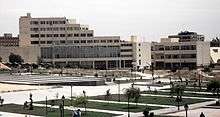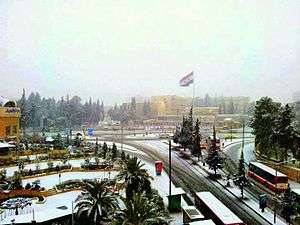University of Aleppo
| جامعة حلب | |
|
The main entrance to the University of Aleppo | |
| Type | Public |
|---|---|
| Established | 1958 |
| President | Dr. Mustafa Afuni |
| Undergraduates | 55,732 |
| Postgraduates | 4,386 |
| 1,525 | |
| Location | Aleppo, Syria |
| Campus | Urban |
| Website | www.alepuniv.edu.sy |
University of Aleppo (Arabic: جامعة حلب, also called Aleppo University) is a public university located in Aleppo, Syria. It is the second largest university in Syria after the University of Damascus.
During 2005-2006 the University had over 61,000 undergraduate students, over 1,500 graduate students and approximately 2,400 faculty members. The university has 25 faculties and 10 intermediate colleges.
History
What was to become the University of Aleppo consisted of a Faculty of Engineering in Aleppo opened in 1946 and affiliated to what is now the University of Damascus (Syrian University at that time). After the end of French rule in 1946, the newly independent Syria only had one university. In 1958, the Syrian government passed a law that created the University of Aleppo as the second university in the country. When the new university opened its doors in 1960, it consisted of two faculties (Civil Engineering and Agriculture). The University grew rapidly in the subsequent decades, formed respected programs in engineering, sciences, and literature, as well as a strong emphasis on languages, offering courses on German, Russian, French, and English.
The university is member of the European Permanent University Forum (EPUF), the Mediterranean Universities Union (UNIMED) and the Regional Corporation Confremo.
The university has joint co-operative programmes with many international institutions of higher educations from the Arab World, United States, Argentina, Venezuela, Australia, Japan, India, Malaysia, Iran, Armenia, Georgia, Turkey, Kazakhstan, Russia, Spain, United Kingdom, Germany, France, Italy, Austria, Norway, Poland, Ukraine, Belgium, Bosnia and Herzegovina, Hungary and Moldova.
During 2008, the University of Aleppo marked its golden jubilee.
On 15 January 2013, 82 people were killed during the Aleppo University bombings at the campus. The blasts reportedly struck an area between Aleppo University's halls of residence and the architecture faculty. The initial death toll was 52, but Aleppo's governor later revised the number.[1]
Structure
Faculties

Aleppo University consists of 25 faculties with 152 departments, among which 18 faculties are located in Aleppo and 7 in Idlib. Studying period is 4 years or above:
- Civil Engineering founded in 1946 as a faculty affiliated with the Syrian University in Damascus. Later in 1958, it became the first faculty of the newly established University of Aleppo:
- Agriculture founded in 1960:
- Basic sciences
- Agricultural economics
- Animal production
- Horticulture
- Renewable natural resources and Environment
- Soil science and Land reclamation
- Food science
- Agronomy
- Rural engineering
- Plant protection
- Law founded in 1960:
- Arts and Humanities founded in 1966:
- Arabic language and literature
- French language and literature
- English Language and literature
- History
- Geography
- Philosophy and Sociology
- Archeology
- Armenian language and literature
- Persian Language and literature
- Economics founded in 1966:
- Business administration
- Accounting
- Statistics and Information systems
- Economics
- Marketing
- Banking and Finance
- Sciences founded in 1966:
- Medicine founded in 1967:
- Dentistry founded in 1979:
- Oral and maxillofacial surgery
- Periodontology
- Oral Medicine
- Pediatric dentistry
- Fixed prosthodontics
- Orthodontics and maxillofacial
- Prosthodontics
- Dental restoration
- Biological and Medical sciences
- Histology and Histopathology
- Basic Dental science
- Electrical and Electronic Engineering founded in 1982:.
- Electrical engineering
- Telecommunications engineering
- Electrical Power engineering
- Mechatronics
- Electronic engineering
- Computer engineering
- Control engineering and Automation
- Architecture founded in 1983:
- Architectural design
- Planning and Environment
- Building science and Implementation
- Architectural theory and history
- Mechanical Engineering founded in 1983:
- Basic sciences
- Applied mechanics
- Power engineering
- Production engineering
- Industrial engineering
- Agricultural machinery engineering
- Nuclear engineering
- Aerospace engineering
- Materials science
- Mechanical spinning and weaving
- Pharmacy founded in 1991:
- Analytical and Food chemistry
- Pharmaceutical chemistry and Drug controlling
- Biochemistry
- Impact of drugs and toxins
- Pharmacognosy
- Pharmaceutics and Pharmaceutical technology
- Education founded in 1997:
- Informatics founded in 2000:
- Artificial intelligence and Natural language processing
- Software engineering and systems
- Network engineering
- Basic sciences
- Technological Engineering founded in 2002:
- Fine Arts founded in 2006:
- Sharia founded in 2006:
- Islamic theology
- Islamic jurisprudence and principles
- Nursing founded in 2007:
- Nursing for adults
- Pediatric nursing
- Obstetrical and gynecological nursing
- Psychiatric and mental health nursing
- Public health nursing
- Nursing management
- Critical care nursing
- Geriatric nursing
- Agriculture II in Idlib founded in 2005:
- Agricultural studies
- Olive production
- Education II in Idlib founded in 2005.
- Arts and Humanities II in Idlib founded in 2005:
- Arabic language and literature
- English Language and literature
- Archeology
- Law II in Idlib founded in 2006:
- Sciences II in Idlib founded in 2007:
- Mathematics
- Veterinary medicine in Idlib founded in 2010.
- Administrative sciences in Idlib founded in 2011.
Higher institutes
Two higher institutes based in Aleppo are operating in the university:
- Higher Institute of the History of Arabic Science founded in 1976:
- History of Applied sciences
- History of Medical sciences
- History of Basic sciences
- Higher Institute of Languages founded in 2003.
Intermediate technical institutes
The university has 12 intermediate technical institutes with eight of them based in Aleppo and four in Idlib. Studying period is for two years:
- Medicine
- Dentistry
- Informatics
- Engineering
- Agriculture
- Accounting and Finance
- Business administration and Marketing
- Mechanical and Electrical
- Informatics in Idlib
- Banking and Finance in Idlib
- Veterinary in Idlib
- Agriculture in Idlib
Open Studies
The Open Studies Centre was inaugurated in 2001. The centre offers degrees in three majors:
- Legal studies
- Computer and informatics
- Minor and intermediate projects
Hospitals
The university runs six hospitals in the city of Aleppo:
- Aleppo University Hospital (AUH)
- Aleppo University Cardiovascular Surgical Centre
- OB/GYN Hospital named after Basil al-Assad
- Oral and Maxillofacial Surgical Centre
- Surgical Ambulance Hospital
- Al-Kindi Hospital (not operating)
Other structures
The university is home to one of the biggest libraries (Central Library of the University)[2] in Syria with more than 1.5 million units. In addition, there are 17 academic centres, a publishing and printing house, and 20 units in the campus, designated to host more than 12 thousand students.
The university publishes its scientific journal periodically which is called Aleppo University Researches.
On 6 February 2010, the university announced the opening of its Radio & TV Centre, which is the first of its type among Syrian universities and the third in the Middle East.[3]
Presidents
- Dr. Tawfik Al-Munajed (1960–67)
- Dr. Mustafa Ezzat Al-Nassar (1968–69)
- Dr. Ahmad Y. al-Hassan (1973–79)
- Dr. Mohammad Ali Huriah (1979–2000)
- Dr. Saeed Farhoud (2001–04)
- Dr. Mohammad Nizar Akil (2005–10)
- Dr. Nidal Shehadeh (2010-2012)
- Dr. Abed Yakan (2012)
- Dr. Kheder Ourfali (2012-2013)
- Dr. Mahmoud Dahhan (2013–14)
- Dr. Mustafa Afuni (2015-..)
References
- ↑ "Syria crisis: Dozens killed by Aleppo university blasts". BBC. Retrieved 15 January 2013.
- ↑ World Guide to Libraries (25 ed.), De Gruyter Saur, 2011
- ↑ "Aksalser news: 6 February 2010".
Coordinates: 36°12′40″N 37°07′06″E / 36.21111°N 37.11833°E
